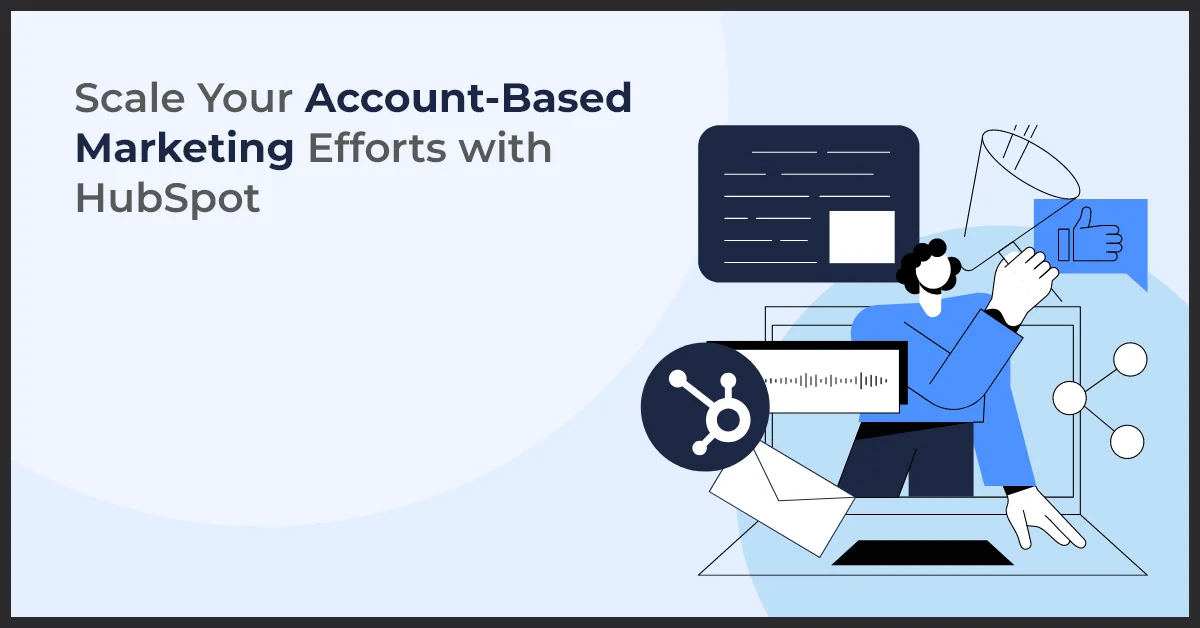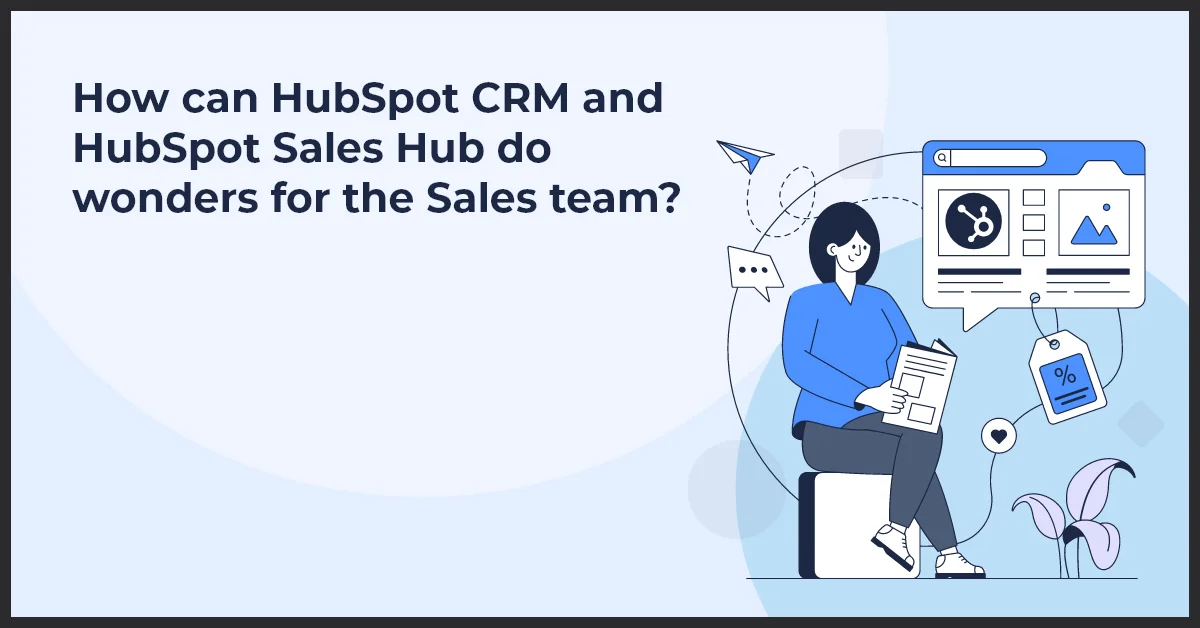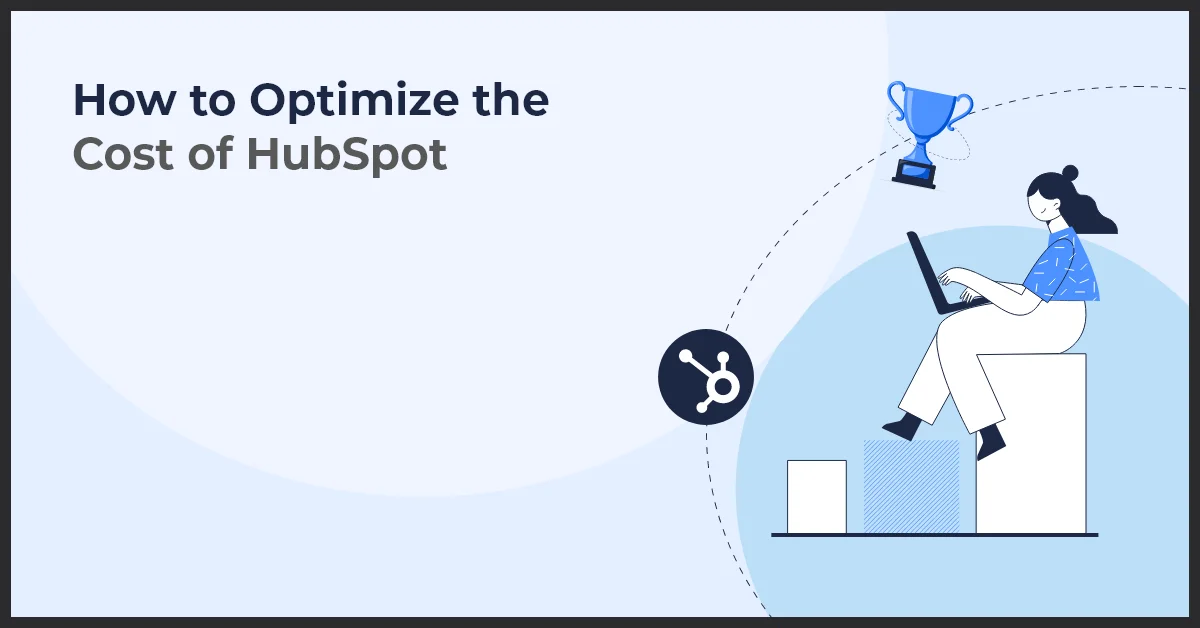Scale Your Account-Based Marketing Efforts with HubSpot

Published on: April 28, 2022
Updated on: July 05, 2024
1625 Views
- HubSpot
16 min read
In today's competitive landscape, ABM has emerged as a smart and efficient way to target high-value accounts and deliver personalized experiences that drive revenue. By focusing on a select group of key accounts, ABM allows marketers to optimize their efforts and tailor their messaging for maximum impact.
However, executing an effective ABM strategy requires the right tools and technology. This is where HubSpot comes in. With its comprehensive suite of features specifically designed for ABM, HubSpot empowers marketers to streamline their workflows, personalize their communications, and track their progress with ease. Whether you are a small start-up or an established enterprise, utilizing HubSpot in your ABM efforts can make all the difference in reaching your target audience, boosting engagement, and ultimately generating more leads and conversions.
Imagine if you could directly engage with your target audience without wasting time on drafting marketing strategies or preparing yourself to sell to unqualified leads. Sounds too good to be true? Well, it’s rather easy with account-based marketing (ABM).
ABM is a B2B marketing approach where the sales and marketing teams work together to target the best fit accounts and convert them into customers. A successful ABM strategy could boost revenue, optimize your efforts, and provide in-depth metrics that might otherwise remain inaccessible.
Using HubSpot helps enhance your ABM plan as you can overcome marketing challenges effortlessly. In fact, it is backed by numbers. About 80% of marketers report an increase in leads due to marketing automation. Using ABM with HubSpot ensures that both marketing and sales are in sync, leading your team to hop on the process of strategizing and creating campaigns to entice and engage with those accounts.
Understanding Account-Based Marketing
Account-Based Marketing (ABM) is a targeted marketing strategy that focuses on engaging and nurturing specific accounts or companies rather than individual leads. It involves identifying key accounts, building relationships with key decision-makers, and delivering personalized content and campaigns that align with their needs and preferences.
Definition and key components of ABM
ABM can be defined as a strategic approach to B2B marketing that involves tailoring marketing efforts to specific accounts or companies. The key components of ABM include:
- Identifying target accounts: ABM starts with identifying and selecting target accounts based on specific criteria such as industry, company size, or revenue potential.
- Building relationships: Once target accounts are identified, the next step is to build relationships with key decision-makers within those accounts. This involves understanding their pain points, goals, and needs.
- Personalizing content: ABM relies heavily on personalization. Marketers create tailored content and campaigns that resonate with the target accounts and address their specific challenges.
- Coordinating sales and marketing: ABM requires close collaboration between sales and marketing teams to align efforts and ensure a seamless experience for the target accounts.
- Measuring and optimizing: Like any marketing strategy, ABM should be measured and optimized. Marketers should track metrics such as engagement, conversion rates, and revenue generated to evaluate the effectiveness of their ABM efforts.
Differentiating ABM from traditional marketing approaches
ABM differs from traditional marketing approaches in several ways:
- Focus: Traditional marketing targets a wide audience, whereas ABM focuses on specific accounts.
- Personalization: ABM delivers personalized content and campaigns tailored to the needs of individual accounts. Traditional marketing often uses a one-size-fits-all approach.
- Metrics: ABM measures success based on account-level metrics such as revenue generated. Traditional marketing typically focuses on lead generation and conversion rates.
- Collaboration: ABM requires close collaboration between sales and marketing teams to align efforts. Traditional marketing often operates independently from sales.
The role of personalization in ABM
Personalization plays a crucial role in ABM. By tailoring content and campaigns to individual accounts, marketers can create a personalized experience that resonates with decision-makers. Personalization helps build trust, enhances engagement, and increases the chances of conversion.
Importance of Scaling ABM Efforts
Scaling your account-based marketing efforts is crucial for achieving sustainable growth and maximizing your return on investment (ROI). By expanding your ABM strategies, you can reach a larger audience of high-value accounts, deepen your relationships with existing customers, and generate more revenue for your business.
Exploring the challenges faced by businesses in scaling ABM
While account-based marketing offers numerous benefits, businesses often face challenges when it comes to scaling their efforts. Some common obstacles include:
- Limited resources and bandwidth to manage a large number of targeted accounts
- Lack of alignment and coordination between sales and marketing teams
- Difficulty in identifying and segmenting target accounts effectively
- Inconsistent or fragmented data management and analysis
These challenges can hinder the success of your ABM initiatives and prevent you from achieving your desired results. That's where HubSpot comes in to help.
Benefits of scaling ABM efforts with HubSpot
HubSpot offers a comprehensive set of tools and features designed to support the scalability of your account-based marketing efforts. By leveraging the power of HubSpot, you can:
- Efficiently manage and prioritize a large number of target accounts
- Align your sales and marketing teams to work together towards common goals
- Gain actionable insights into your target accounts and their behaviors
- Automate and streamline your ABM processes for increased efficiency
These benefits not only enable you to scale your ABM efforts effectively but also empower your teams to focus on the most valuable accounts and drive meaningful results.
Implementing ABM at scale to drive higher ROI
When you scale your account-based marketing efforts with HubSpot, you can drive higher ROI by:
- Targeting a larger pool of high-value accounts with personalized campaigns
- Delivering relevant and timely content to engage and nurture your target accounts
- Improving lead generation and conversion rates through targeted advertising
- Enhancing sales and marketing alignment to increase efficiency and effectiveness
By implementing ABM at scale with HubSpot, you can optimize your marketing strategies, deepen customer relationships, and ultimately boost your revenue.
5 Ways HubSpot Can Help Scale Your Account-Based Marketing (ABM) Efforts
If you are wondering how HubSpot can enhance your marketing efforts, let’s show you how:
1. Identify Target Accounts
Any ABM effort starts by listing out potential target accounts for your business. If you don’t have a dedicated list, HubSpot can easily help you identify good-fit accounts you should target. Even if you have identified your ideal customer profile, you can easily filter them in your HubSpot customer relationship management software (CRM) by the characteristics of your ICP.
HubSpot's inbuilt CRM can help align departments within your organization and even track real-time progress. Once you have filtered your ICP and decided on a marketing approach, you will be left with a list of accounts matching closely to your target audience.
2. Create Account-Based Marketing (ABM) Chatflows
As you begin to generate ABM-specific content, a HubSpot chatflow is a great method to engage your target accounts directly with the material you've created for them. You can use a chatflow to target a specific list of accounts so that your chat flows only appear to those accounts. So, regardless of how the target account arrived on your website, you can make sure they get the content you want them to read without sharing it with people who aren't on your list.
3. Do In-Depth Reporting
Knowing where your strengths are and what needs to be addressed for optimum participation is the cornerstone of any effective ABM strategy. You may report on a variety of levels using HubSpot, from marketing and sales through the pipeline.
Your dashboards can also provide up-to-date visualizations with real-time data, allowing your team to gain insight into the engagement and performance of various campaigns. You can even create dashboards based on any metric by using HubSpot’s reporting features.
4. Create Landing Pages
You can use the HubSpot CMS to collect data from your CRM and use it to create dynamic content for your landing pages. You may use personalization tokens to directly address contacts at your target accounts by name, company, title, and any other information you have recorded in your CRM when you build out your landing pages. You can develop tailored landing pages at scale across a subset of your target accounts using these customization tokens.
5. Automate Your Marketing Campaigns
Marketing automation can be the key difference between a B2B company working with a few key clients and generating large volumes of leads from the individuals who matter most to them.
Within your ABM campaign, HubSpot's marketing automation software can discover certain triggers to segment specific data sets, engage with prospects automatically, and better nurture individuals who are unsure about committing to an opportunity.
Leveraging HubSpot for Account-Based Marketing
HubSpot is a game-changer when it comes to account-based marketing (ABM). With its comprehensive ABM software, HubSpot empowers marketers to take their ABM efforts to new heights. Let's explore how you can leverage HubSpot for account-based marketing.
Overview of HubSpot as a Comprehensive ABM Software
HubSpot is not just any ordinary marketing software. It is specifically designed to assist businesses in implementing effective account-based marketing strategies. From gathering customer data to delivering personalized experiences, HubSpot does it all.
Key Features and Capabilities of HubSpot for ABM Strategies
HubSpot offers a wide range of features and capabilities to supercharge your ABM strategies. Its powerful tools help you manage contacts, track interactions, create targeted campaigns, and measure results. With HubSpot, you can effortlessly implement personalized marketing at scale.
Integrating HubSpot with Existing Marketing and Sales Processes
Integration is a breeze with HubSpot. You can seamlessly connect HubSpot with your existing marketing and sales processes. This ensures smooth data flow across platforms and enables your team to work collaboratively. With HubSpot, your ABM efforts will be in perfect sync with your overall marketing strategy.
Using HubSpot to Identify and Segment Target Accounts
HubSpot offers a range of powerful features that can help businesses identify and segment their target accounts effectively. By utilizing HubSpot's account segmentation capabilities, companies can ensure that their marketing efforts are targeted towards the most relevant and valuable accounts.
To begin with, defining ideal customer profiles (ICPs) is crucial for targeted marketing. HubSpot allows businesses to create detailed ICPs based on specific criteria such as company size, industry, and job title. This enables marketers to understand their target audience better and tailor their marketing messages to resonate with them.
In addition, HubSpot's tools can assist in identifying high-value accounts. By analyzing various data points such as revenue, industry influence, and engagement history, businesses can prioritize their efforts towards accounts that are most likely to convert and bring significant value.
Using HubSpot's account-based marketing tools not only streamlines the process of identifying and segmenting target accounts but also provides valuable insights for effective marketing strategies.
Personalizing Marketing Content and Email Campaigns
Leveraging HubSpot to deliver personalized content to target accounts
When it comes to Account-Based Marketing (ABM), personalization is key. With HubSpot, you can easily create and deliver personalized content to your target accounts. By tailoring your messaging and content to the specific needs and pain points of your accounts, you can increase engagement and drive better results.
Best practices for creating customized email campaigns using HubSpot
Email campaigns are a powerful tool in ABM, and HubSpot provides several features to help you create and deliver highly personalized campaigns. Start by segmenting your target accounts based on their specific attributes, such as industry, company size, or location. This will allow you to craft targeted messages that resonate with each segment.
Using dynamic content and smart CTAs to maximize personalization
HubSpot's dynamic content and smart CTAs allow you to take personalization even further. Dynamic content enables you to display different content blocks within an email or on a webpage based on the recipient's attributes. This means you can tailor your message based on the individual's role, interests, or previous interactions with your brand.
Smart CTAs take personalization to the next level by displaying different calls-to-action based on the recipient's stage in the buying journey. This allows you to guide your target accounts through the customer lifecycle with relevant and compelling offers.
By leveraging HubSpot's personalization features, you can ensure that your marketing content and email campaigns are highly targeted and relevant to each individual account. This level of personalization will not only increase engagement but also help you build stronger relationships with your target accounts.
Implementing Targeted Advertising with HubSpot
Implementing targeted advertising is a crucial component of an effective account-based marketing (ABM) strategy. By leveraging HubSpot's advertising tools, you can ensure that your ads are reaching the right audience and driving meaningful engagement. In this section, we will explore the role of targeted advertising in ABM, how to run targeted ad campaigns using HubSpot, and how to measure and optimize your advertising efforts through HubSpot analytics.
Understanding the Role of Targeted Advertising in ABM
Targeted advertising plays a vital role in ABM as it allows you to focus your marketing efforts on specific accounts that are most likely to convert. Unlike traditional advertising, which casts a wide net, targeted advertising helps you deliver relevant messages to your target accounts, increasing the likelihood of capturing their attention and generating quality leads.
How to Run Targeted Ad Campaigns Using HubSpot's Advertising Tools
HubSpot's advertising tools provide you with the necessary features to create and manage targeted ad campaigns seamlessly. With HubSpot, you can create custom audiences based on your target account segments, ensuring that your ads are shown to the right people at the right time.
- Define your target account segments: Identify the specific segments within your target accounts and create custom audiences in HubSpot.
- Create ad campaigns: Leverage HubSpot's ad creation tools to design compelling ad creatives that resonate with your target accounts.
- Set up ad targeting: Use HubSpot's targeting capabilities to specify the characteristics of your target audience, such as job titles, industries, or company sizes.
- Launch and monitor campaigns: Once your ad campaigns are set up, monitor their performance through HubSpot's analytics dashboards to track impressions, clicks, and conversions.
Measuring and Optimizing Advertising Efforts Through HubSpot Analytics
HubSpot's powerful analytics features enable you to measure and optimize your advertising efforts, ensuring that you achieve the best possible results. By tracking the performance of your ads, you can analyze which campaigns and targeting strategies are most effective. HubSpot provides valuable insights and data that you can use to refine your advertising strategy and improve your overall ABM efforts.
In conclusion, implementing targeted advertising with HubSpot is an essential step in maximizing the success of your account-based marketing efforts. By understanding the role of targeted advertising, leveraging HubSpot's advertising tools, and measuring and optimizing your advertising efforts through HubSpot analytics, you can effectively reach and engage your target accounts, driving greater revenue and business growth.
Enhancing Sales and Marketing Alignment with HubSpot
Aligning the efforts of your sales and marketing teams is crucial for the success of your account-based marketing (ABM) efforts. When both teams are working together towards a common goal, the chances of converting target accounts into customers increase significantly. HubSpot's comprehensive suite of features and tools can help enhance this alignment, ensuring a seamless collaboration between sales and marketing.
Importance of aligning sales and marketing teams in ABM
In traditional marketing approaches, there is often a misalignment between the sales and marketing teams. However, in ABM, where the focus is on targeting specific accounts, it becomes even more important for these teams to work in harmony. When sales and marketing are aligned, they can share valuable insights, collaborate on account strategies, and provide a consistent messaging and experience to potential customers.
Leveraging HubSpot's CRM features to align sales and marketing efforts
HubSpot's robust CRM (Customer Relationship Management) capabilities play a vital role in aligning sales and marketing efforts for ABM. The CRM allows both teams to access and update customer and prospect data in real-time. This shared database ensures that sales and marketing have a complete view of the interactions and activities of each target account. With this information, both teams can coordinate their efforts, prioritize leads, and deliver a personalized experience throughout the customer journey.
Using HubSpot to track and measure marketing's impact on sales revenue
One of the significant advantages of using HubSpot for ABM is the ability to track and measure the impact of marketing efforts on sales revenue. HubSpot's analytics and reporting tools provide insights into how marketing activities, such as personalized campaigns and targeted advertising, are contributing to revenue generation. This data enables the sales team to understand the effectiveness of the marketing strategies and adjust their approach accordingly to maximize conversion rates.
Hence, when utilizing HubSpot for ABM, sales and marketing alignment becomes a seamless and powerful collaboration. With shared data, coordinated efforts, and measurable results, your teams can work together towards the common goal of acquiring and retaining high-value target accounts.
Marketing Automation with HubSpot
Marketing automation plays a crucial role in Account-Based Marketing (ABM) efforts, providing businesses with the ability to automate repetitive tasks and deliver personalized experiences at scale. With HubSpot, businesses can effectively streamline their ABM campaigns and achieve greater efficiency and effectiveness.
Overview of Marketing Automation and its Benefits in ABM
Marketing automation refers to the use of technology to automate marketing processes and tasks. In the context of ABM, marketing automation enables businesses to automate various aspects of their ABM campaigns, including lead generation, nurturing, and customer engagement.
By utilizing marketing automation in ABM, businesses can:
- Save time and resources by automating repetitive tasks
- Deliver highly personalized experiences at scale
- Increase operational efficiency and productivity
- Improve lead generation and nurturing
- Enhance customer engagement and satisfaction
Utilizing HubSpot's Automation Features to Streamline ABM Campaigns
HubSpot offers a comprehensive set of automation features designed to streamline ABM campaigns and maximize their impact. With HubSpot, businesses can:
- Create personalized email workflows based on specific account attributes and behaviors
- Automatically segment and prioritize target accounts based on predefined criteria
- Trigger automated tasks and follow-ups based on specific events or actions
- Automate lead scoring and nurturing processes to identify and prioritize high-value accounts
- Track and analyze the effectiveness of ABM campaigns through comprehensive reporting and analytics
Improving Lead Generation and Nurturing through Automated Workflows
HubSpot's marketing automation capabilities enable businesses to improve lead generation and nurturing in their ABM efforts. By implementing automated workflows, businesses can:
- Capture and qualify leads more effectively with personalized content and offers
- Engage and nurture leads through automated email campaigns tailored to their specific needs
- Track and analyze lead behavior to identify potential opportunities for sales engagement
- Automatically assign leads to relevant sales representatives based on predefined criteria
With HubSpot's marketing automation features, businesses can automate their ABM campaigns, streamline processes, and achieve better results in lead generation and nurturing.
Conclusion
A truly robust Account-Based Marketing plan requires much more than a well-organized target account list, and HubSpot's ABM tools are a great place to start as you consider implementing a long-term ABM approach.
Need help implementing an ABM campaign using HubSpot? Growth Natives to the rescue! As a HubSpot Diamond Partner with a deep understanding of how to functionally implement ABM strategies, we are here to help you maximize your ROI.



